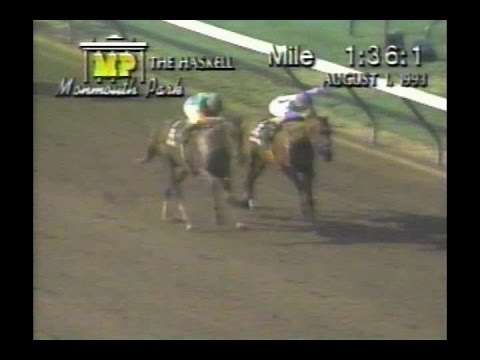The 1993 Haskell Invitational Stakes at Monmouth Park Racetrack (New Jersey) was a compelling moment in American thoroughbred racing — a Grade I event for three-year-olds held over 1⅛ miles on the dirt. bloodhorse.com+3Wikipedia+3gohorsebetting.com+3 That year’s running stood out not only for its fiercely competitive field but also for the emergence of a horse who would cement his place in racing history: Kissin Kris.
Background & Context
By 1993, the Haskell had firmly established itself as one of the premier mid-summer races for three-year-olds in between the U.S. Triple Crown series and the later fall big stakes. Wikipedia+1 At this stage of the season, many top three-year-olds have already contested the Kentucky Derby, Preakness and Belmont — and the Haskell offers a chance to prove themselves further, or for late-bloomers to shine.
Heading into the race, Kissin Kris was among the better‐regarded horses in his division. According to winner lists, he took the 1993 Haskell. gohorsebetting.com+1 The chart for the race shows the date as August 1, 1993 and the distance as 1⅛ miles. equibase.com What makes his victory notable is that this win added to his career earnings and paved the way for his post-race reputation. bloodhorse.com
The Race Itself
When you watch the video, you’ll want to observe the pace dynamics, the tactics of Kissin Kris and his jockey (Jose A. Santos) and how they navigated the field. According to historical records, Kissin Kris was ridden by Jose A. Santos and trained by David R. Bell. gohorsebetting.com
In the Haskell you’ll see the horses break from the gate, jockeys vying for position into the first turn, and the journey of 1⅛ miles (≈9 furlongs) playing out. The critical moments: how the lead changes, how the backstretch develops, who takes over on the far turn, and the final stretch duel.
Kissin Kris showed a measure of resolve and tactical versatility. While I do not have a full blow‐by‐blow positional chart in my source list, the fact that he won and the time recorded (1:49.58) indicates a solid performance. gohorsebetting.com+1 Time and track condition also matter: Monmouth’s surface, weather conditions, and the competition that day all influence how the race plays out.
Why It Matters
There are several reasons why the 1993 Haskell is a meaningful race in the broader context of U.S. racing:
- Emergence of Kissin Kris – This win elevated Kissin Kris’s career and earnings. Before his later ventures (including standing at stud), this Haskell win added to his credentials. bloodhorse.com
- Mid‐Season Test for Three-Year-Olds – As one of the premier summer races for the age group, the Haskell offered a platform to reaffirm or recalibrate a horse’s credentials post-Triple Crown.
- Strategic Implications – The race challenges horsemen to manage three-year-olds who have already had lengthy seasons, possibly with Triple Crown appearances or other heavy campaigns. How fresh the horse is, how tactical the ride is, and how well positioned you are going into the final turn all weigh heavily.
- Legacy & Records – The Haskell has hosted many future champions, and although not every winner becomes an all-time great, winning a Grade I at this distance and level puts you in elite company. Wikipedia+1

What to Watch in the Video
- Break & early lead: See how Kissin Kris breaks and whether he hustles for early position or settles behind.
- Pace scenario: Which horse leads? Is there a fast early pace that could set up for a closer?
- Far turn move: The turn into the stretch is often where races at 1⅛ miles are decided. Watch how Kissin Kris and his jockey navigate the turn, whether wide or tight, and how much ground they make up or give away.
- Stretch duel: The final furlong (≈200 m) is where the heart shows. Does Kissin Kris have to dig in? Does he pull away easily?
- Finish & time: As mentioned his time is recorded as roughly 1:49.58 for the race. gohorsebetting.com+1 Consider how that time compares to others, and how strong the other horses finishing behind were.
- Competition: Identify who the runners-up were, how they traveled, whether they were tiring or closing strongly. While I don’t have full details on all participants in the 1993 field from my sources, you can often tell from the video.
- Turf/Track condition clues: Watch the surface sensitivity, splash, kickback from the dirt, and how it might affect horses running wide or on the rail. Track condition often plays a hidden part.
- Jockey & trainer tactics: Notice how Santos steers, positions his mount, and when he asks for effort. Also note whether the trainer had aimed for this target race or if the horse is showing signs of wear.
Reflections & Legacy
Looking back, the 1993 Haskell win by Kissin Kris stands as a testament to a horse handling a key stakes assignment at the right time. For fans and handicappers, this race serves as a blueprint: a horse who is three, distance capable, well ridden, and peaking at the right moment can make the difference.
Also, for historians, the Haskell’s place in the calendar makes it a bell-wether for future success. While not every Haskell winner becomes a Triple Crown winner, or a Horse of the Year, the winners often are among the best of their generation. For Kissin Kris, the win furthered his stature.
When you watch the video, take time to absorb not just the winner, but the nuance: how the field shapes up, how inside and outside lanes play out, how the jockeys adjust to track bias (if any) and how the race evolves from gate to wire over 1⅛ miles.
Whether you’re a thoroughbred racing fan, a student of equine strategy, or just someone looking for a highlight race from the early ’90s, the 1993 Haskell offers a rich viewing experience. The setting at Monmouth, the three‐year-old age group, and the summer stakes ambience all combine to make this a memorable edition.


